I build a simple LSTM model in Keras as below:
model = Sequential()
model.add(keras.layers.LSTM(hidden_nodes, input_dim=num_features, input_length=window, consume_less="mem"))
model.add(keras.layers.Dense(num_features, activation='sigmoid'))
optimizer = keras.optimizers.SGD(lr=learning_rate, decay=1e-6, momentum=0.9, nesterov=True)
When I apply the model on some data I have this particular behaviour:

Where the orange line represents the predicted values and the blue one the grand truth.
As you can see, the network repeats previous values but it's not what I want. I have several features (not only the one shown in the pictures) and I want the network takes into account the dependencies with other time series instead of look just at past data of a single and repeats previous data.
I hope the questions is clear enough!
My data
I have 36 time series (categorical and numerical data). I use a window of length W and I resheape the data in order to create a numpy vector in the form required in Keras (num_samples, window, num_features).
Edit 1
Sample of data:
0.5, 0.1, 0.4, 1, 0,74
0.1, 0.1, 0.8, 0.9, 0,8
0.2, 0.3, 0.5, 1, 0,85
I have one categorical and two numerical attributes. The first three rows refer to the categorical one (one-hot encoding for categorical). Last two refer to two numerical attributes.
I build training and test as shown below:

So I execute model.fit(T, X).
I've also tried with a low number of Hidden Nodes but the result it's the same.
Edit 2
The custom loss function that takes into account the use of numerical and categorical features:
def mixed_num_cat_loss_backend(y_true, y_pred, signals_splits):
if isinstance(y_true, np.ndarray):
y_true = keras.backend.variable( y_true )
if isinstance(y_pred, np.ndarray):
y_pred = keras.backend.variable( y_pred )
y_true_mse = y_true[:,:signals_splits[0]]
y_pred_mse = y_pred[:,:signals_splits[0]]
mse_loss_v = keras.backend.square(y_true_mse-y_pred_mse)
categ_loss_v = [ keras.backend.categorical_crossentropy(
y_pred[:,signals_splits[i-1]:signals_splits[i]],
y_true[:,signals_splits[i-1]:signals_splits[i]],
from_logits=False) # force keras to normalize
for i in range(1,len(signals_splits)) ]
losses_v = keras.backend.concatenate( [mse_loss_v, keras.backend.stack(categ_loss_v,1)], 1)
return losses_v
I use model.fit(T, X) in order to know where the numerical features are (in the matrix).
This is the function that prepares data by starting from a 2D numpy array, as shown in the pictures with M,T,X:
def prepare_training_data(data_matrix, boundaries, window = 5):
num_rows, num_columns = data_matrix.shape
effective_sizes = [max(0,(nrows - window)) for nrows in boundaries]
total_training_rows = sum(effective_sizes)
print " - Skipped dumps because smaller than window:", sum([z==0 for z in effective_sizes])
# prepare target variables
T = data_matrix[window:boundaries[0],:]
start_row = boundaries[0]
for good_rows, total_rows in zip(effective_sizes[1:],boundaries[1:]):
if good_rows>0:
T = np.vstack( (T,data_matrix[start_row+window:start_row+total_rows,:]) )
start_row += total_rows
# check concatenate
# training input to the LSTM
X = np.zeros((total_training_rows, window, num_columns))
curr_row = 0
curr_boundary = 0
for good_rows, total_rows in zip(effective_sizes,boundaries):
for i in range(good_rows):
X[curr_row] = data_matrix[curr_boundary+i:curr_boundary+i+window,:]
curr_row += 1
curr_boundary += total_rows
return X,T,effective_sizes